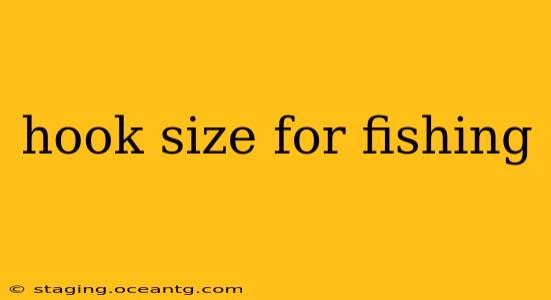Choosing the right hook size is crucial for successful fishing. It significantly impacts your ability to catch fish, affecting everything from hooksets to preventing escapes. This comprehensive guide will delve into the intricacies of hook sizes, helping you select the perfect hook for your target species and fishing conditions.
What Determines Hook Size?
Several factors influence the appropriate hook size for fishing:
-
Target Species: Different fish species have different mouth sizes and fighting styles. Larger fish naturally require larger hooks, while smaller fish need smaller hooks to avoid injury and ensure a secure hold.
-
Bait or Lure Size: The hook size should be proportionate to the size of your bait or lure. Too small a hook might not adequately hold the bait, while too large a hook might overwhelm it, making it less appealing to fish.
-
Fishing Technique: Certain fishing techniques necessitate specific hook sizes. For example, fly fishing often uses smaller hooks, whereas big game fishing utilizes significantly larger ones.
-
Water Conditions: In murky or heavily vegetated waters, slightly larger hooks might be preferable for better penetration and hooksets.
Understanding Hook Size Numbering: The Smaller the Number, the Larger the Hook
Hook sizes are typically represented by numbers, and it's counterintuitive: smaller numbers indicate larger hooks, while larger numbers indicate smaller hooks. This system can vary slightly between manufacturers, but the general principle remains consistent. For instance, a size 1 hook is much larger than a size 10 hook.
Common Hook Sizes and Their Applications:
Here's a general guideline for hook sizes and their common applications:
-
Sizes 1/0 - 8/0 (and larger): Used for large game fish such as tuna, marlin, and sharks. These are incredibly strong hooks designed to handle powerful fish.
-
Sizes 1 - 6: Suitable for a wide range of freshwater and saltwater species, including bass, trout, redfish, and snapper. These are versatile hooks for many common fishing scenarios.
-
Sizes 6 - 12: Frequently used for smaller panfish like bluegill, crappie, and perch, as well as smaller trout and other finesse fishing applications.
-
Sizes 12 and smaller: Often used in fly fishing and ultra-light tackle applications, targeting smaller fish with delicate presentations.
What Hook Size Should I Use for [Specific Fish Species]?
This is a frequently asked question, and the answer is nuanced. There isn't a single "correct" size for each fish species. However, here's a general idea:
What hook size should I use for bass?
Bass fishing utilizes a wide range of hook sizes, depending on the size of the bass targeted and the type of bait used. For smaller bass, sizes 2-6 are commonly employed, while larger bass may require hooks in the 1/0-4/0 range.
What hook size should I use for trout?
Trout hook sizes vary significantly depending on the size of the trout and the fishing method used. Smaller trout might be caught on sizes 8-12, whereas larger trout could require sizes 2-6.
What hook size should I use for catfish?
Catfish require strong hooks capable of withstanding their powerful bites. Sizes 2/0-8/0 are frequently used, depending on the catfish's size. Circle hooks are often preferred for catfish to minimize injury.
How to Choose the Right Hook: A Step-by-Step Guide
-
Identify your target species: Research the average size of the fish you intend to catch.
-
Select your bait or lure: The hook size should complement the bait or lure's size and weight.
-
Consider your fishing technique: Different techniques may call for different hook styles and sizes.
-
Check the hook's strength and sharpness: Ensure the hook is appropriately strong for the size of fish you expect to catch. Sharp hooks are essential for successful hooksets.
-
Experiment and adjust: Don't be afraid to experiment with different hook sizes to find what works best for you and your fishing conditions.
By carefully considering these factors, you can significantly increase your chances of a successful fishing trip. Remember, choosing the right hook size is a crucial aspect of successful fishing, leading to more catches and a more enjoyable experience.
